
blades
Blades is a Go-based multimodal AI Agent framework.
Stars: 393
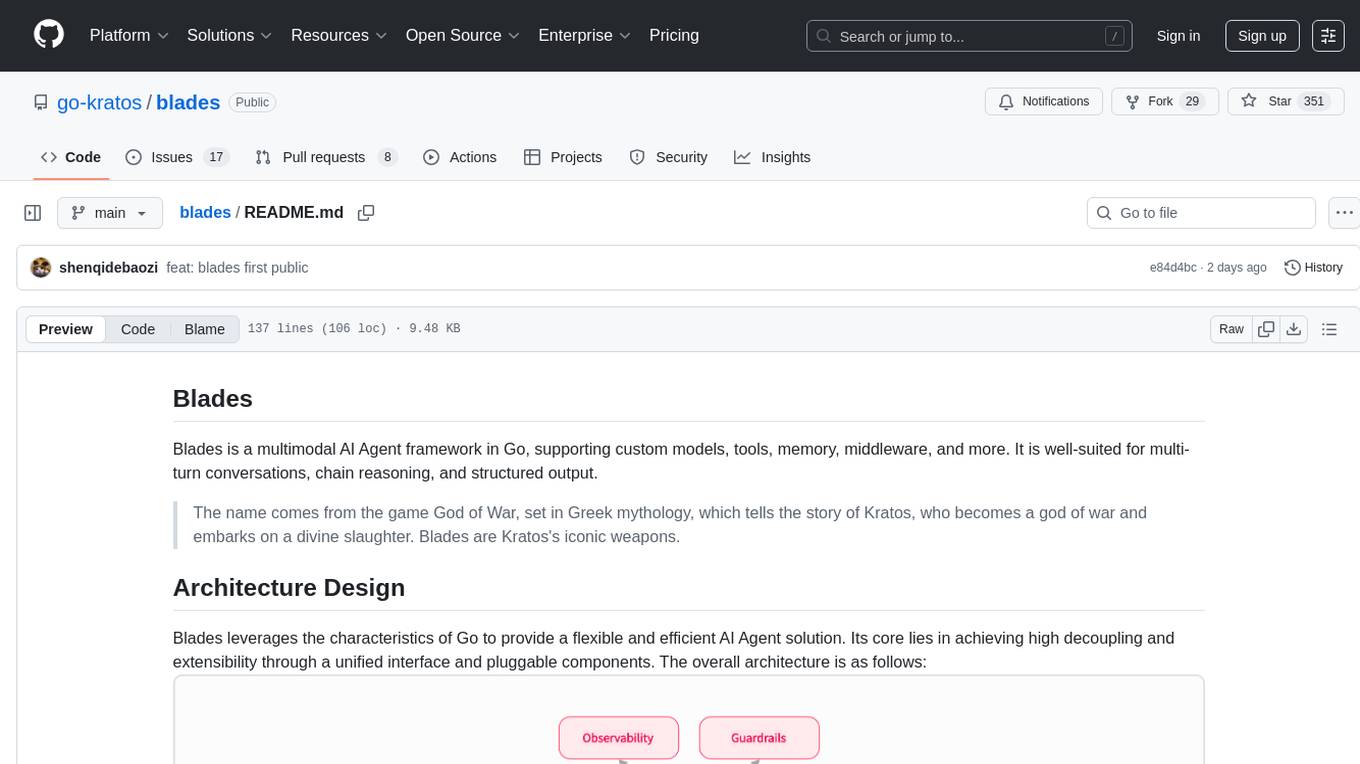
Blades is a multimodal AI Agent framework in Go, supporting custom models, tools, memory, middleware, and more. It is well-suited for multi-turn conversations, chain reasoning, and structured output. The framework provides core components like Agent, Prompt, Chain, ModelProvider, Tool, Memory, and Middleware, enabling developers to build intelligent applications with flexible configuration and high extensibility. Blades leverages the characteristics of Go to achieve high decoupling and efficiency, making it easy to integrate different language model services and external tools. The project is in its early stages, inviting Go developers and AI enthusiasts to contribute and explore the possibilities of building AI applications in Go.
README:
Blades is a multimodal AI Agent framework in Go, supporting custom models, tools, memory, middleware, and more. It is well-suited for multi-turn conversations, chain reasoning, and structured output.
The name comes from the game God of War, set in Greek mythology, which tells the story of Kratos, who becomes a god of war and embarks on a divine slaughter. Blades are Kratos's iconic weapons.
Blades leverages the characteristics of Go to provide a flexible and efficient AI Agent solution. Its core lies in achieving high decoupling and extensibility through a unified interface and pluggable components. The overall architecture is as follows:

- Go Idiomatic: Built entirely in the Go way, the code style and user experience make Go developers feel at home.
- Easy to Use: Through concise code, define an AI Agent and quickly deliver requirements, making complex logic clear, easy to manage, and maintain.
- Middleware Ecosystem: Drawing inspiration from Kratos’s middleware design philosophy, features like Observability, Guardrails, and others can be easily integrated into the AI Agent.
- Highly Extensible: Through a unified interface and pluggable components, achieve high decoupling and extensibility, making it easy to integrate different LLM models and external tools.
The Blades framework achieves its powerful functionality and flexibility through a series of well-designed core components. These components work together to build the intelligent behavior of the Agent:
- Agent (Intelligent Entity): The core unit that executes tasks, capable of invoking models and tools.
- Prompt (Prompt Text): A templated text used to interact with LLMs, supporting dynamic variable substitution and complex context construction.
- Chain (Chain): Links multiple Agents or other Chains to form complex workflows.
- ModelProvider (Model): A pluggable LLM interface, allowing you to easily switch and integrate different language model services (such as OpenAI).
- Tool (Tool): External capabilities that the Agent can use, such as calling APIs, querying databases, accessing file systems, etc.
- Memory (Memory): Provides short-term or long-term memory capabilities for the Agent, enabling context-aware continuous conversations.
- Middleware (Middleware): Similar to middleware in web frameworks, it can implement cross-cutting control over the Agent.
Runner is the most core interface in the Blades framework, defining the basic behavior of all executable components. Its design aims to provide a unified execution paradigm, achieving decoupling, standardization, and high composability of various functional modules within the framework through the Run and RunStream methods. Components such as Agent, Chain, and ModelProvider all implement this interface, unifying their execution logic and allowing different components to be flexibly combined like LEGO bricks to build complex AI Agents.
// Runner represents an entity that can process prompts and generate responses.
type Runner interface {
// Run performs a synchronous, non-streaming operation, returning a complete Generation result.
Run(context.Context, *Prompt, ...ModelOption) (*Generation, error)
// RunStream performs an asynchronous, streaming operation, returning a Streamer for receiving Generation results step by step.
RunStream(context.Context, *Prompt, ...ModelOption) (Streamer[*Generation], error)
}ModelProvider is the core abstraction layer in the Blades framework for interacting with underlying large language models (LLMs). Its design goal is to achieve decoupling and extensibility through a unified interface, separating the framework's core logic from the implementation details of specific models (such as OpenAI, DeepSeek, Gemini, etc.). It acts as an adapter, responsible for converting standardized requests within the framework into the format required by the native API of the model and converting the model's response back into the framework's standard format, thus allowing developers to easily switch and integrate different LLMs.
type ModelProvider interface {
// Generate performs a complete generation request and returns the result at once. Suitable for scenarios where real-time feedback is not needed.
Generate(context.Context, *ModelRequest, ...ModelOption) (*ModelResponse, error)
// NewStream initiates a streaming request. This method immediately returns a Streamer object, through which the caller can receive the generated content from the model step by step, suitable for building real-time, typewriter-effect conversation applications.
NewStream(context.Context, *ModelRequest, ...ModelOption) (Streamer[*ModelResponse], error)
}Agent is the core orchestrator in the Blades framework. As the highest-level Runner, it integrates and orchestrates ModelProvider, Tool, Memory, and Middleware components to understand user intent and execute complex tasks. Its design allows for flexible configuration through Option functions, driving the behavior and capabilities of intelligent applications, and fulfilling core responsibilities such as task orchestration, context management, and instruction following.
Chain is used to build complex workflows and multi-step reasoning. Its design philosophy is to sequentially link multiple Runner instances, enabling the transfer of data and control flow, where the output of one Runner can serve as the input for the next Runner. This mechanism allows developers to flexibly combine components, build highly customized AI workflows, and achieve multi-step reasoning and complex data processing, which is key to implementing the Agent's complex decision-making flows.
Tool is a key component for extending the capabilities of an AI Agent, representing external functions or services that the Agent can call. Its design aims to empower the Agent with the ability to interact with the real world, perform specific actions, or obtain external information. Through a clear InputSchema, it guides the LLM to generate the correct call parameters and executes the actual logic through an internal Handle function, thereby encapsulating various external APIs, database queries, etc., into a form that the Agent can understand and invoke.
The Memory component endows the AI Agent with memory capabilities, providing a general interface for storing and retrieving conversation messages, ensuring that the Agent maintains context and coherence in multi-turn conversations. Its design supports managing messages by session ID and can be configured with message quantity limits to balance the breadth of memory and system resource consumption. The framework provides an InMemory implementation and also encourages developers to extend to persistent storage or more complex memory strategies.
type Memory interface {
AddMessages(context.Context, string, []*Message) error
ListMessages(context.Context, string) ([]*Message, error)
Clear(context.Context, string) error
}Middleware is a powerful mechanism for implementing cross-cutting concerns such as logging, monitoring, authentication, and rate limiting. Its design allows for injecting additional behaviors into the Runner execution flow without modifying the core Runner logic. It works in an "onion model" function chain, providing highly flexible flow control and functional enhancements, thus decoupling non-core business logic from core functionality.
Below is a simple chat Agent example, demonstrating how to use the OpenAI ModelProvider to build a basic conversation application:
package main
import (
"context"
"log"
"github.com/go-kratos/blades"
"github.com/go-kratos/blades/contrib/openai"
)
func main() {
agent := blades.NewAgent(
"Template Agent",
blades.WithModel("gpt-5"),
blades.WithProvider(openai.NewChatProvider()),
)
// Define templates and params
params := map[string]any{
"topic": "The Future of Artificial Intelligence",
"audience": "General reader",
}
// Build prompt using the template builder
// Note: Use exported methods when calling from another package.
prompt, err := blades.NewPromptTemplate().
System("Please summarize {{.topic}} in three key points.", params).
User("Respond concisely and accurately for a {{.audience}} audience.", params).
Build()
if err != nil {
log.Fatal(err)
}
log.Println("Generated Prompt:", prompt.String())
// Run the agent with the templated prompt
result, err := agent.Run(context.Background(), prompt)
if err != nil {
log.Fatal(err)
}
log.Println(result.Text())
}For more examples, see the examples directory.
The project is currently in its early stages, and we are continuously iterating rapidly. We sincerely invite all Go developers and AI enthusiasts to visit our GitHub repository and personally experience the joy of development with Blades.
Feel free to give the project a ⭐️ Star, explore more usage in the examples directory, or get started building your first Go LLM application!
We look forward to any feedback, suggestions, and contributions to jointly promote the prosperity of the Go AI ecosystem.
Blades is licensed under the MIT License. For more details, please refer to the LICENSE file.
For Tasks:
Click tags to check more tools for each tasksFor Jobs:
Alternative AI tools for blades
Similar Open Source Tools

blades
Blades is a multimodal AI Agent framework in Go, supporting custom models, tools, memory, middleware, and more. It is well-suited for multi-turn conversations, chain reasoning, and structured output. The framework provides core components like Agent, Prompt, Chain, ModelProvider, Tool, Memory, and Middleware, enabling developers to build intelligent applications with flexible configuration and high extensibility. Blades leverages the characteristics of Go to achieve high decoupling and efficiency, making it easy to integrate different language model services and external tools. The project is in its early stages, inviting Go developers and AI enthusiasts to contribute and explore the possibilities of building AI applications in Go.
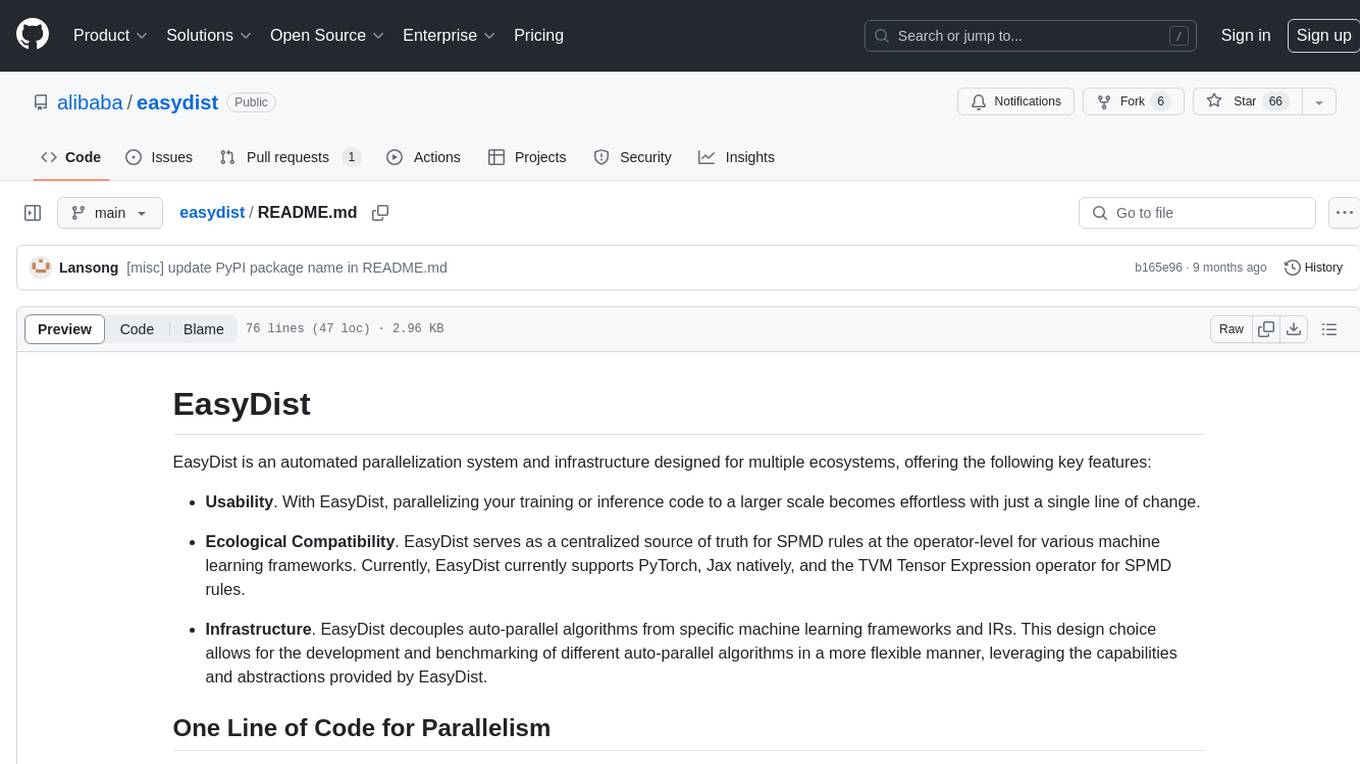
easydist
EasyDist is an automated parallelization system and infrastructure designed for multiple ecosystems. It offers usability by making parallelizing training or inference code effortless with just a single line of change. It ensures ecological compatibility by serving as a centralized source of truth for SPMD rules at the operator-level for various machine learning frameworks. EasyDist decouples auto-parallel algorithms from specific frameworks and IRs, allowing for the development and benchmarking of different auto-parallel algorithms in a flexible manner. The architecture includes MetaOp, MetaIR, and the ShardCombine Algorithm for SPMD sharding rules without manual annotations.
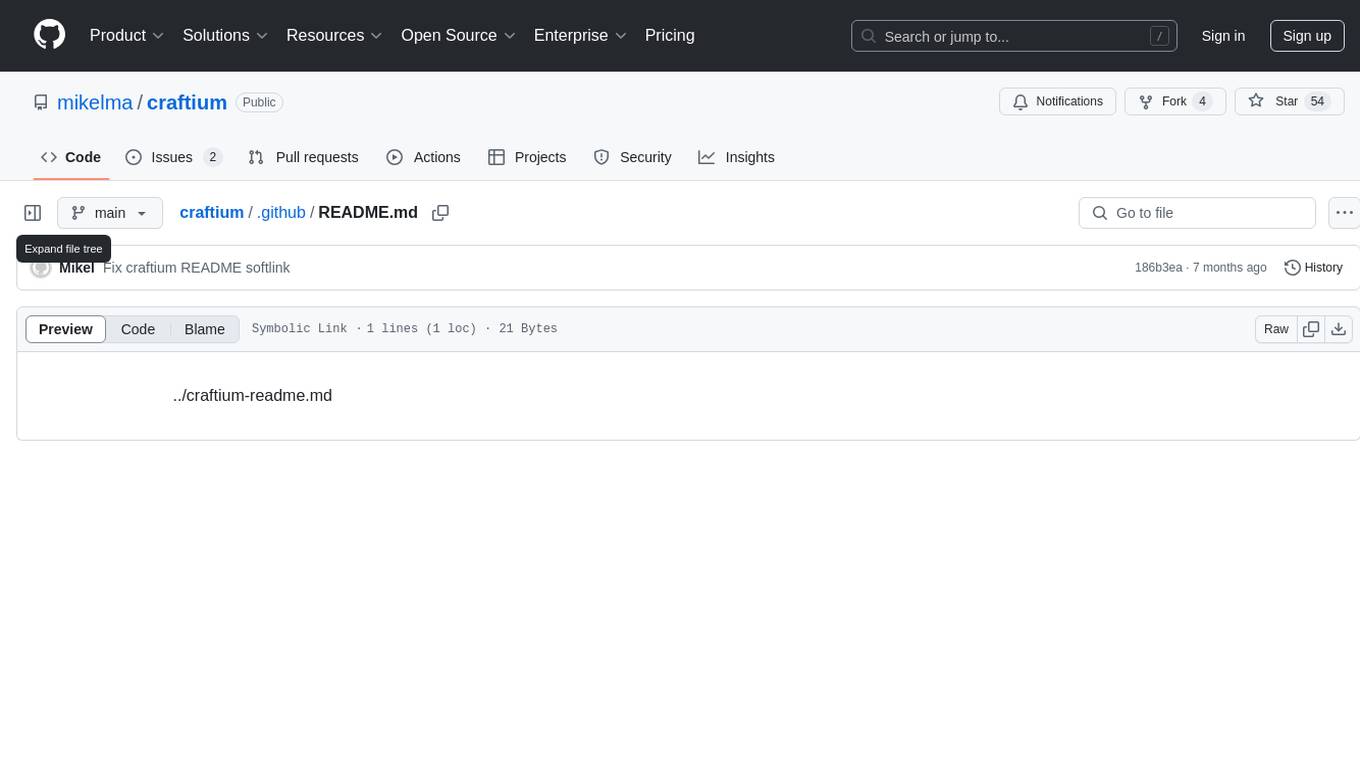
craftium
Craftium is an open-source platform based on the Minetest voxel game engine and the Gymnasium and PettingZoo APIs, designed for creating fast, rich, and diverse single and multi-agent environments. It allows for connecting to Craftium's Python process, executing actions as keyboard and mouse controls, extending the Lua API for creating RL environments and tasks, and supporting client/server synchronization for slow agents. Craftium is fully extensible, extensively documented, modern RL API compatible, fully open source, and eliminates the need for Java. It offers a variety of environments for research and development in reinforcement learning.
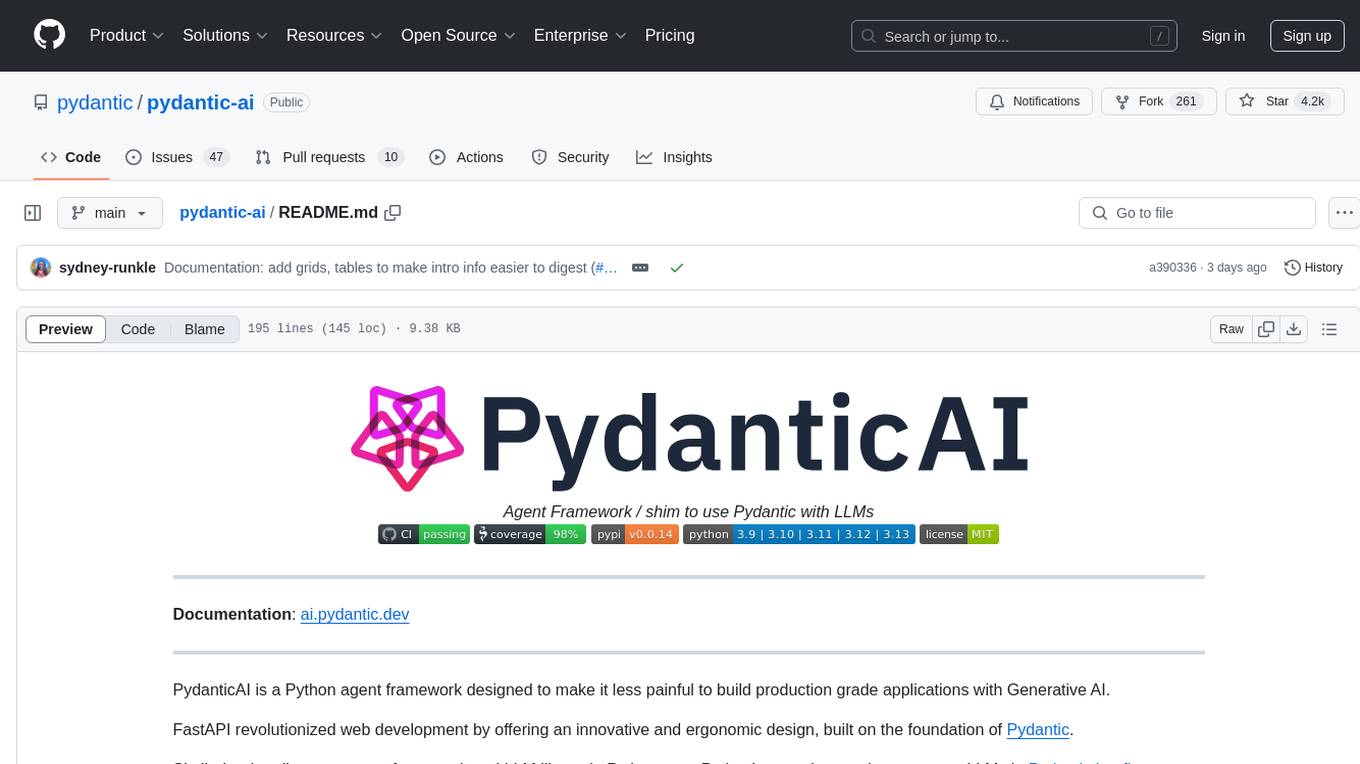
pydantic-ai
PydanticAI is a Python agent framework designed to make it less painful to build production grade applications with Generative AI. It is built by the Pydantic Team and supports various AI models like OpenAI, Anthropic, Gemini, Ollama, Groq, and Mistral. PydanticAI seamlessly integrates with Pydantic Logfire for real-time debugging, performance monitoring, and behavior tracking of LLM-powered applications. It is type-safe, Python-centric, and offers structured responses, dependency injection system, and streamed responses. PydanticAI is in early beta, offering a Python-centric design to apply standard Python best practices in AI-driven projects.
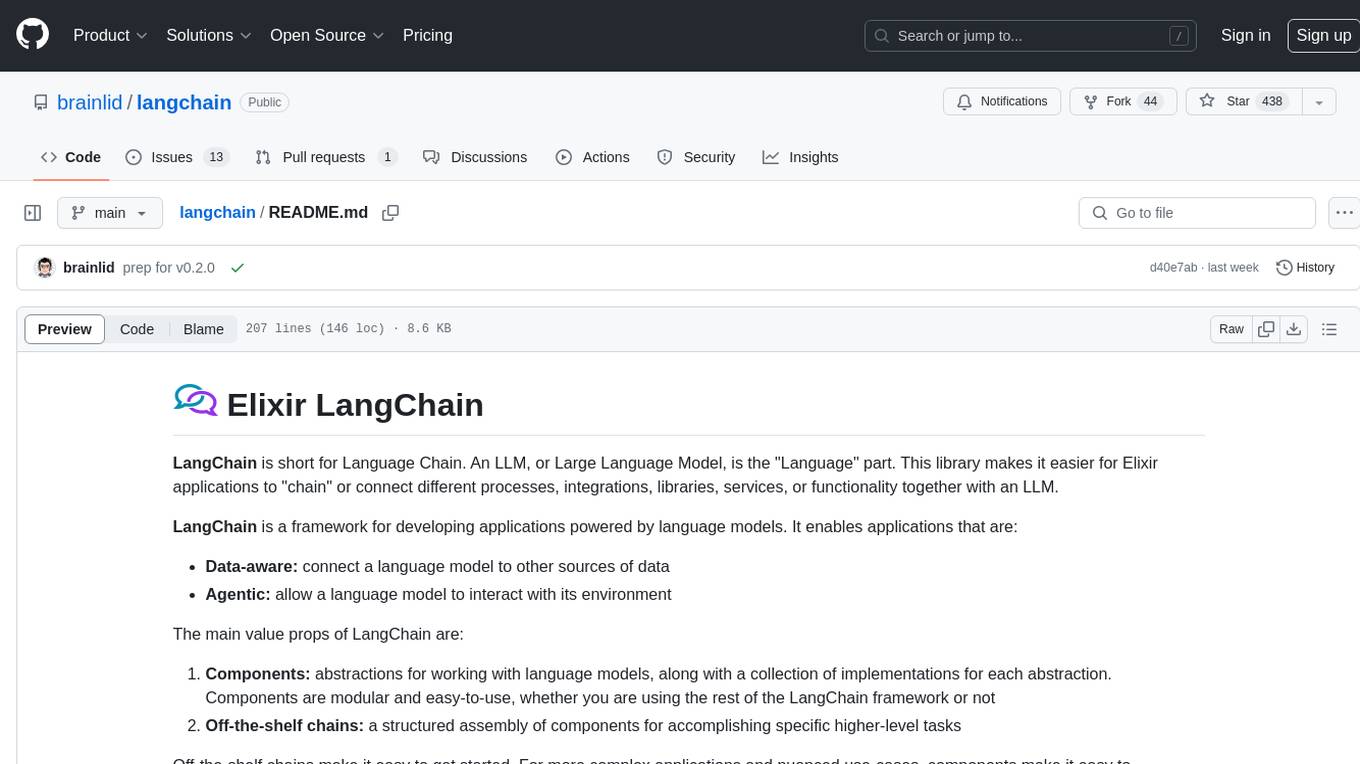
langchain
LangChain is a framework for developing Elixir applications powered by language models. It enables applications to connect language models to other data sources and interact with the environment. The library provides components for working with language models and off-the-shelf chains for specific tasks. It aims to assist in building applications that combine large language models with other sources of computation or knowledge. LangChain is written in Elixir and is not aimed for parity with the JavaScript and Python versions due to differences in programming paradigms and design choices. The library is designed to make it easy to integrate language models into applications and expose features, data, and functionality to the models.
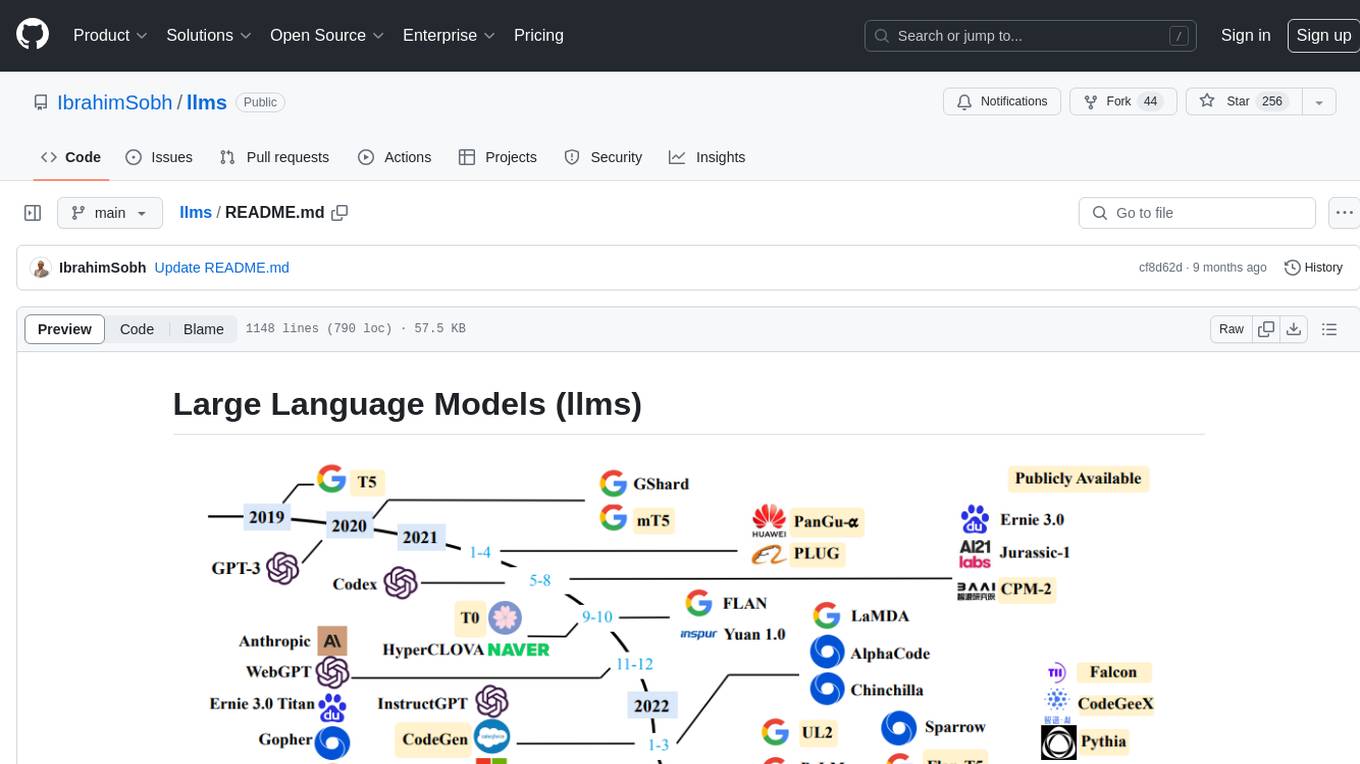
llms
The 'llms' repository is a comprehensive guide on Large Language Models (LLMs), covering topics such as language modeling, applications of LLMs, statistical language modeling, neural language models, conditional language models, evaluation methods, transformer-based language models, practical LLMs like GPT and BERT, prompt engineering, fine-tuning LLMs, retrieval augmented generation, AI agents, and LLMs for computer vision. The repository provides detailed explanations, examples, and tools for working with LLMs.
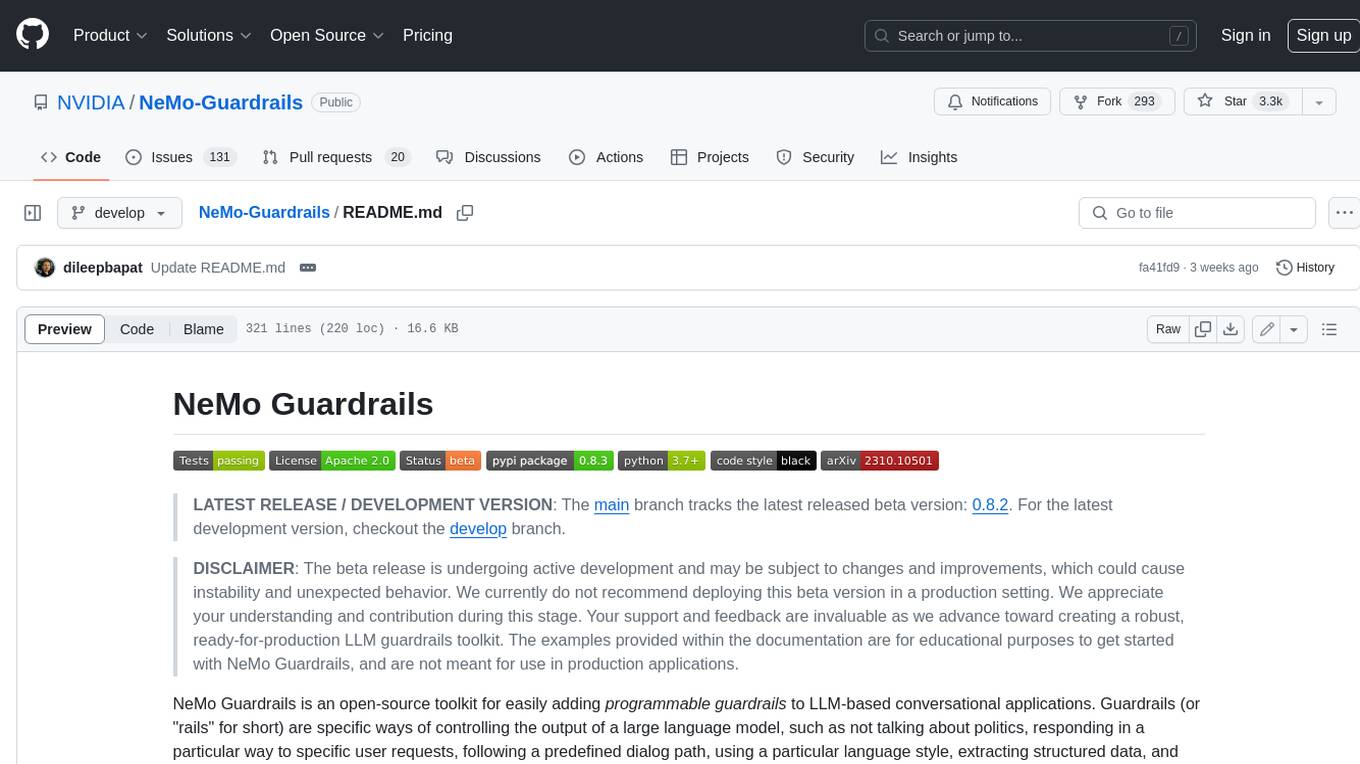
Guardrails
Guardrails is a security tool designed to help developers identify and fix security vulnerabilities in their code. It provides automated scanning and analysis of code repositories to detect potential security issues, such as sensitive data exposure, injection attacks, and insecure configurations. By integrating Guardrails into the development workflow, teams can proactively address security concerns and reduce the risk of security breaches. The tool offers detailed reports and actionable recommendations to guide developers in remediation efforts, ultimately improving the overall security posture of the codebase. Guardrails supports multiple programming languages and frameworks, making it versatile and adaptable to different development environments. With its user-friendly interface and seamless integration with popular version control systems, Guardrails empowers developers to prioritize security without compromising productivity.
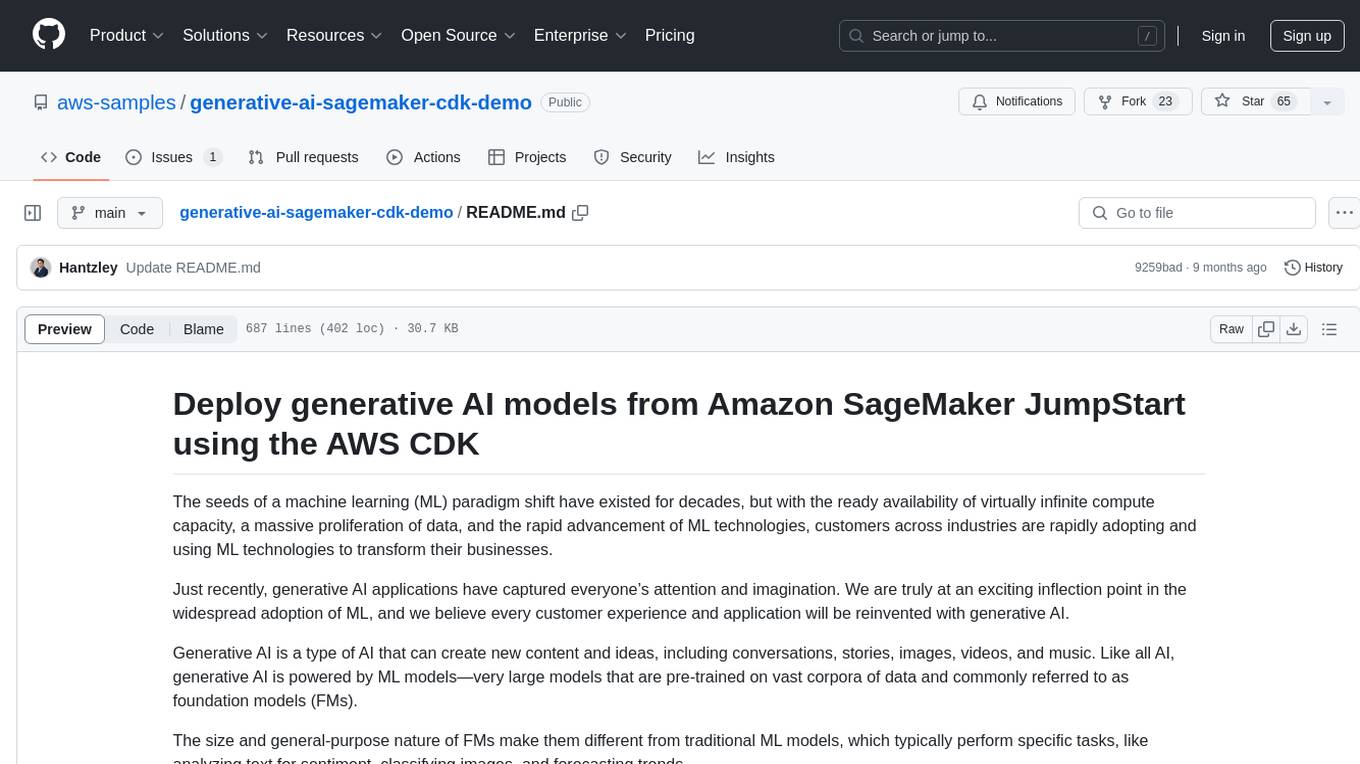
generative-ai-sagemaker-cdk-demo
This repository showcases how to deploy generative AI models from Amazon SageMaker JumpStart using the AWS CDK. Generative AI is a type of AI that can create new content and ideas, such as conversations, stories, images, videos, and music. The repository provides a detailed guide on deploying image and text generative AI models, utilizing pre-trained models from SageMaker JumpStart. The web application is built on Streamlit and hosted on Amazon ECS with Fargate. It interacts with the SageMaker model endpoints through Lambda functions and Amazon API Gateway. The repository also includes instructions on setting up the AWS CDK application, deploying the stacks, using the models, and viewing the deployed resources on the AWS Management Console.
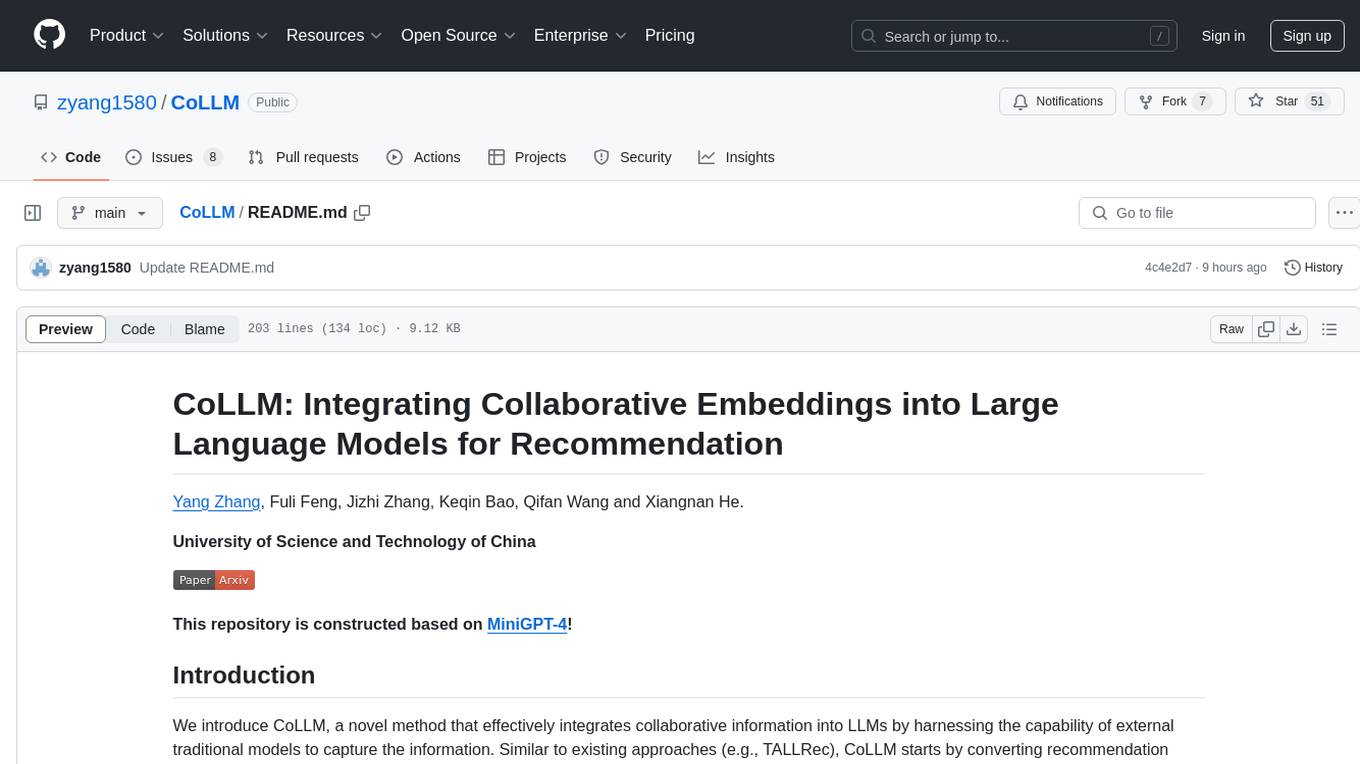
CoLLM
CoLLM is a novel method that integrates collaborative information into Large Language Models (LLMs) for recommendation. It converts recommendation data into language prompts, encodes them with both textual and collaborative information, and uses a two-step tuning method to train the model. The method incorporates user/item ID fields in prompts and employs a conventional collaborative model to generate user/item representations. CoLLM is built upon MiniGPT-4 and utilizes pretrained Vicuna weights for training.
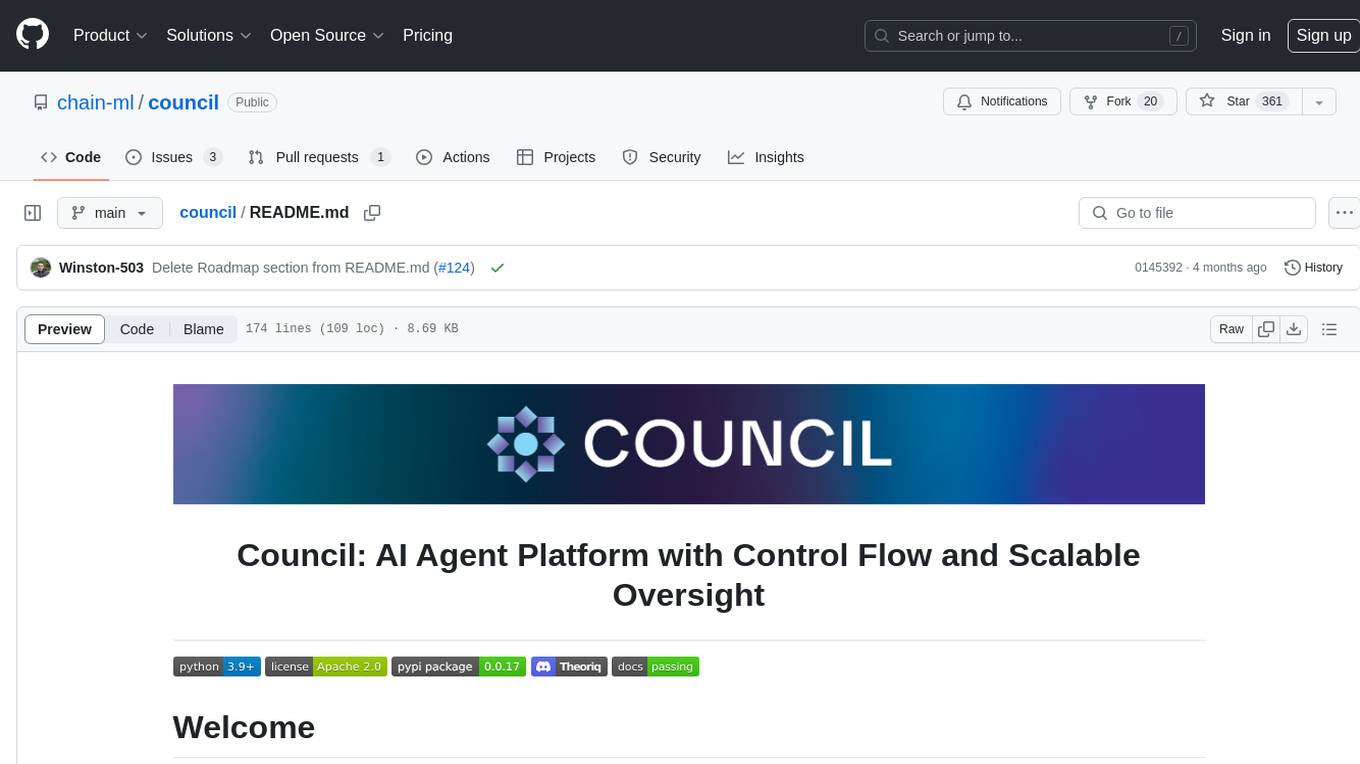
council
Council is an open-source platform designed for the rapid development and deployment of customized generative AI applications using teams of agents. It extends the LLM tool ecosystem by providing advanced control flow and scalable oversight for AI agents. Users can create sophisticated agents with predictable behavior by leveraging Council's powerful approach to control flow using Controllers, Filters, Evaluators, and Budgets. The framework allows for automated routing between agents, comparing, evaluating, and selecting the best results for a task. Council aims to facilitate packaging and deploying agents at scale on multiple platforms while enabling enterprise-grade monitoring and quality control.
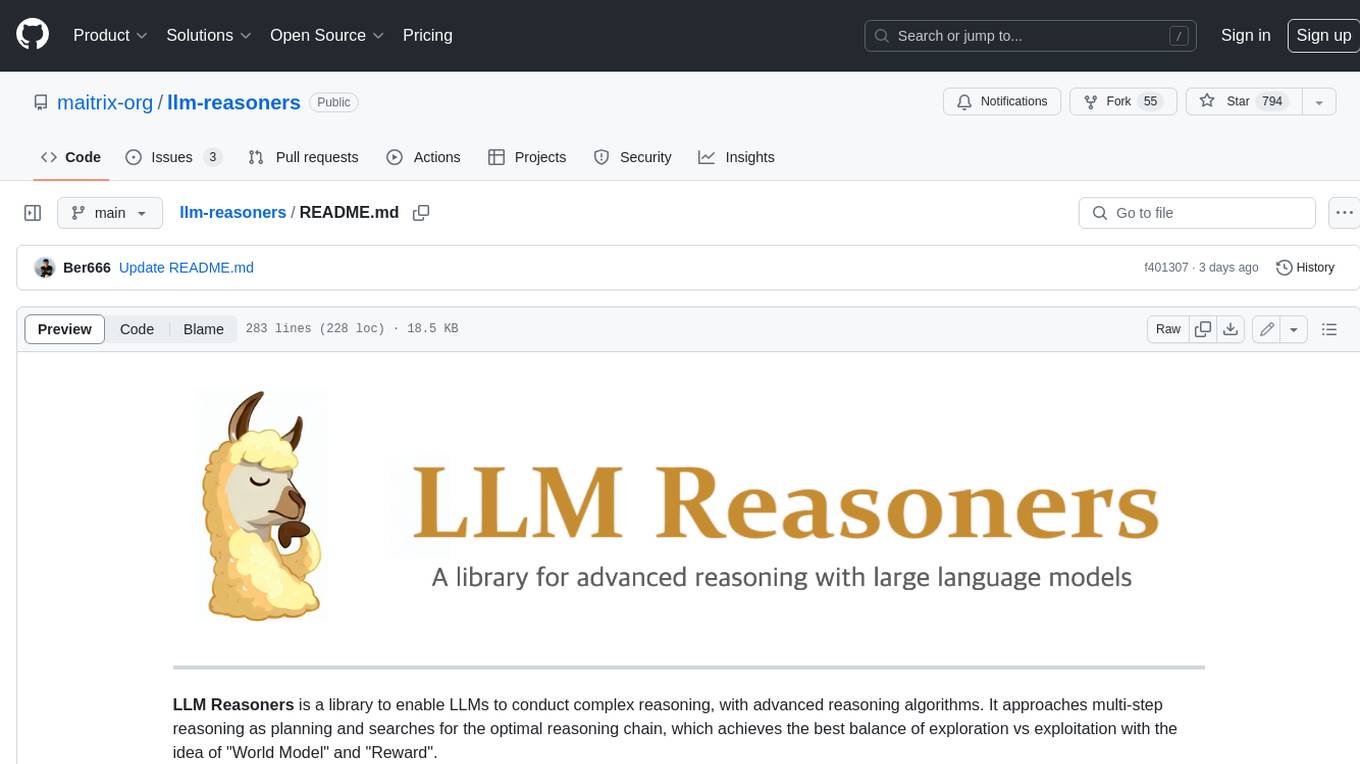
llm-reasoners
LLM Reasoners is a library that enables LLMs to conduct complex reasoning, with advanced reasoning algorithms. It approaches multi-step reasoning as planning and searches for the optimal reasoning chain, which achieves the best balance of exploration vs exploitation with the idea of "World Model" and "Reward". Given any reasoning problem, simply define the reward function and an optional world model (explained below), and let LLM reasoners take care of the rest, including Reasoning Algorithms, Visualization, LLM calling, and more!
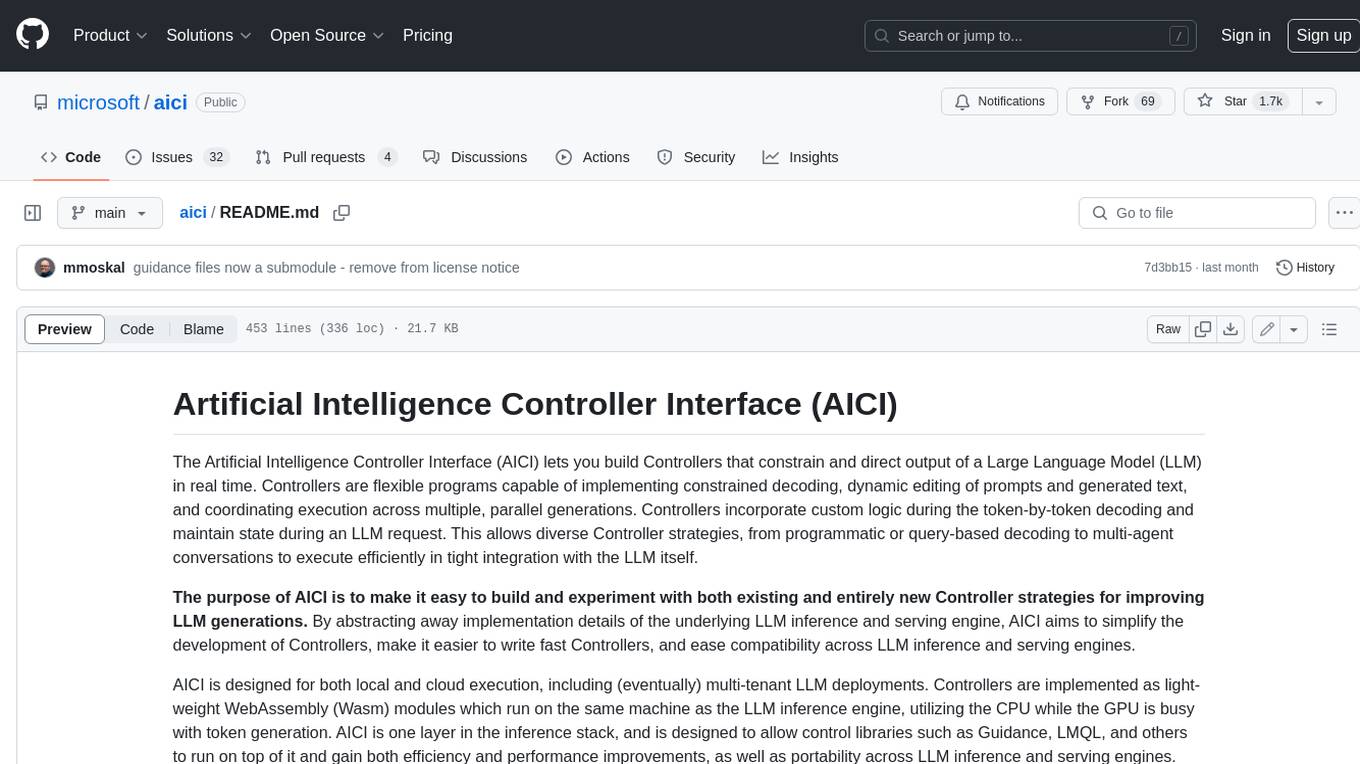
aici
The Artificial Intelligence Controller Interface (AICI) lets you build Controllers that constrain and direct output of a Large Language Model (LLM) in real time. Controllers are flexible programs capable of implementing constrained decoding, dynamic editing of prompts and generated text, and coordinating execution across multiple, parallel generations. Controllers incorporate custom logic during the token-by-token decoding and maintain state during an LLM request. This allows diverse Controller strategies, from programmatic or query-based decoding to multi-agent conversations to execute efficiently in tight integration with the LLM itself.
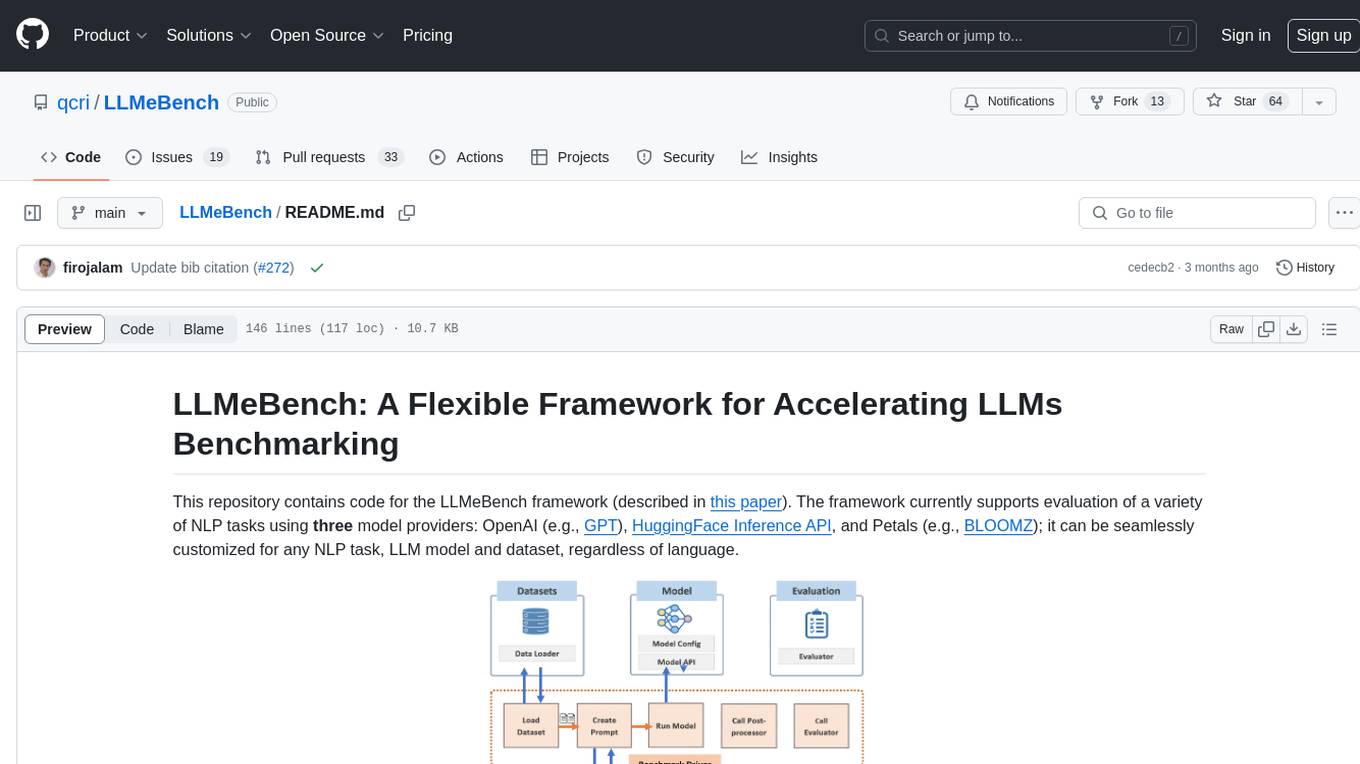
LLMeBench
LLMeBench is a flexible framework designed for accelerating benchmarking of Large Language Models (LLMs) in the field of Natural Language Processing (NLP). It supports evaluation of various NLP tasks using model providers like OpenAI, HuggingFace Inference API, and Petals. The framework is customizable for different NLP tasks, LLM models, and datasets across multiple languages. It features extensive caching capabilities, supports zero- and few-shot learning paradigms, and allows on-the-fly dataset download and caching. LLMeBench is open-source and continuously expanding to support new models accessible through APIs.
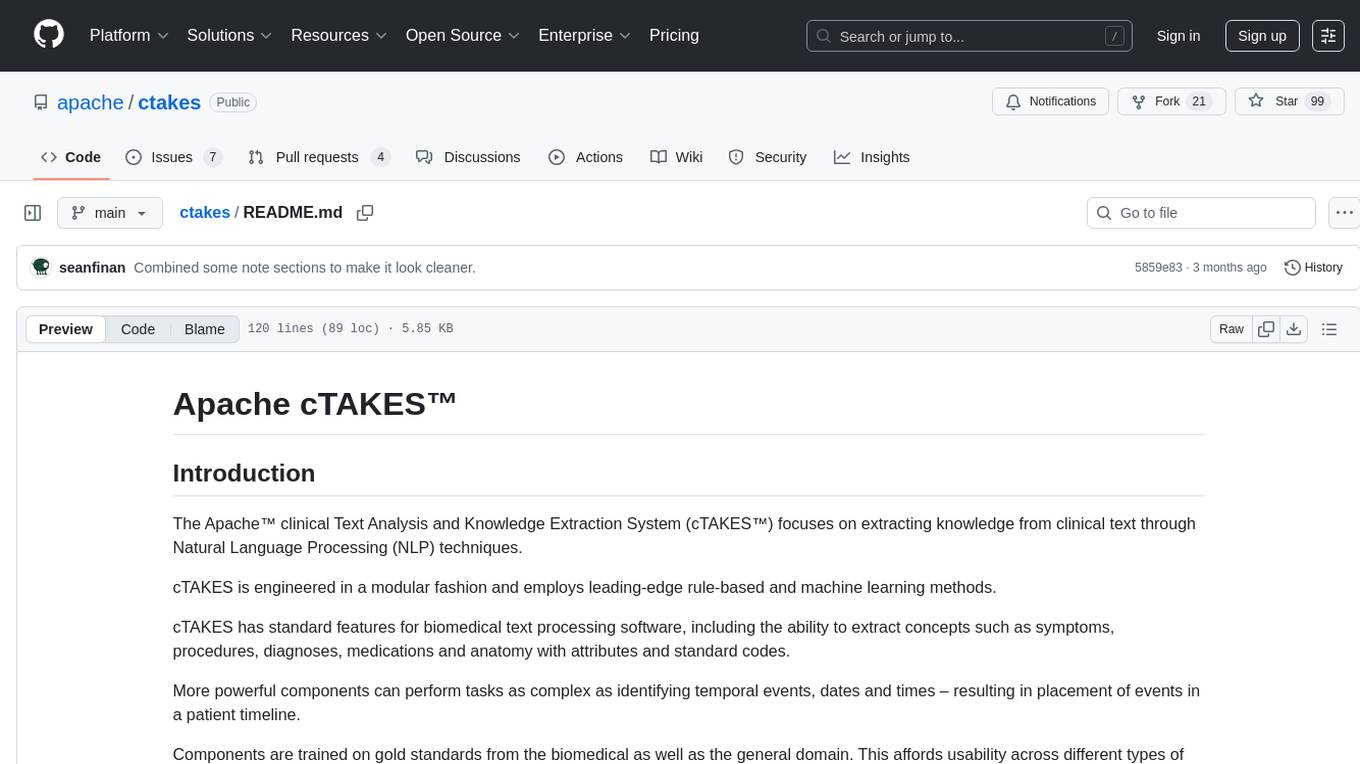
ctakes
Apache cTAKES is a clinical Text Analysis and Knowledge Extraction System that focuses on extracting knowledge from clinical text through Natural Language Processing (NLP) techniques. It is modular and employs rule-based and machine learning methods to extract concepts such as symptoms, procedures, diagnoses, medications, and anatomy with attributes and standard codes. cTAKES can identify temporal events, dates, and times, placing events in a patient timeline. It supports various biomedical text processing tasks and can handle different types of clinical and health-related narratives using multiple data standards. cTAKES is widely used in research initiatives and encourages contributions from professionals, researchers, doctors, and students from diverse backgrounds.
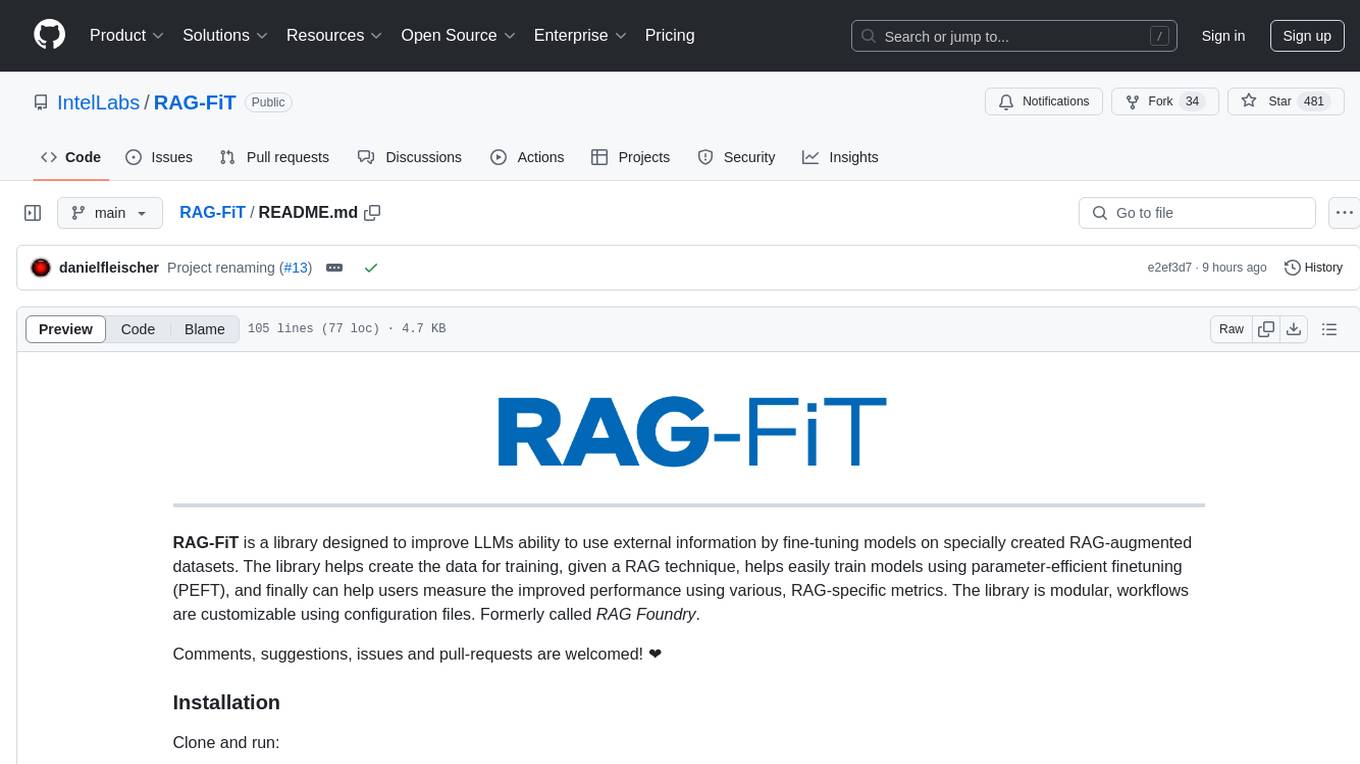
RAG-FiT
RAG-FiT is a library designed to improve Language Models' ability to use external information by fine-tuning models on specially created RAG-augmented datasets. The library assists in creating training data, training models using parameter-efficient finetuning (PEFT), and evaluating performance using RAG-specific metrics. It is modular, customizable via configuration files, and facilitates fast prototyping and experimentation with various RAG settings and configurations.
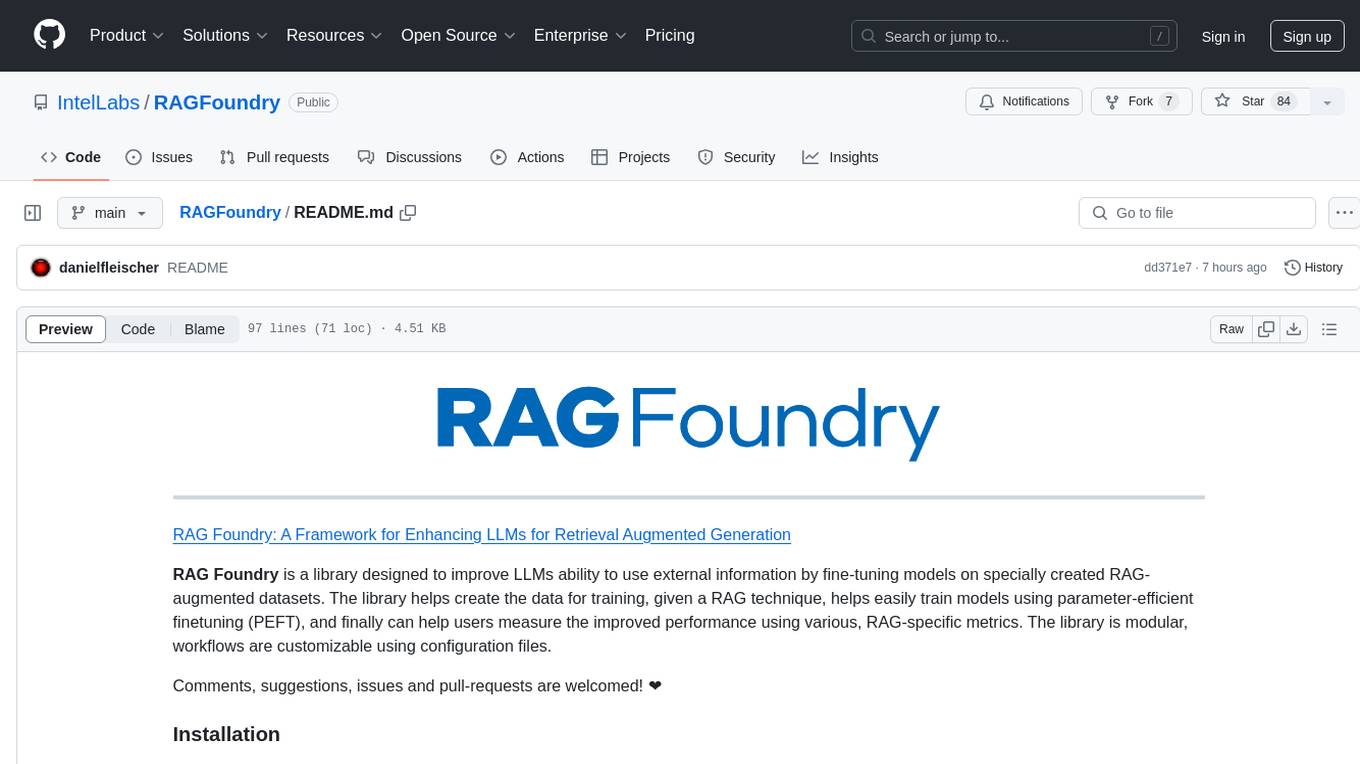
RAGFoundry
RAG Foundry is a library designed to enhance Large Language Models (LLMs) by fine-tuning models on RAG-augmented datasets. It helps create training data, train models using parameter-efficient finetuning (PEFT), and measure performance using RAG-specific metrics. The library is modular, customizable using configuration files, and facilitates prototyping with various RAG settings and configurations for tasks like data processing, retrieval, training, inference, and evaluation.
For similar tasks
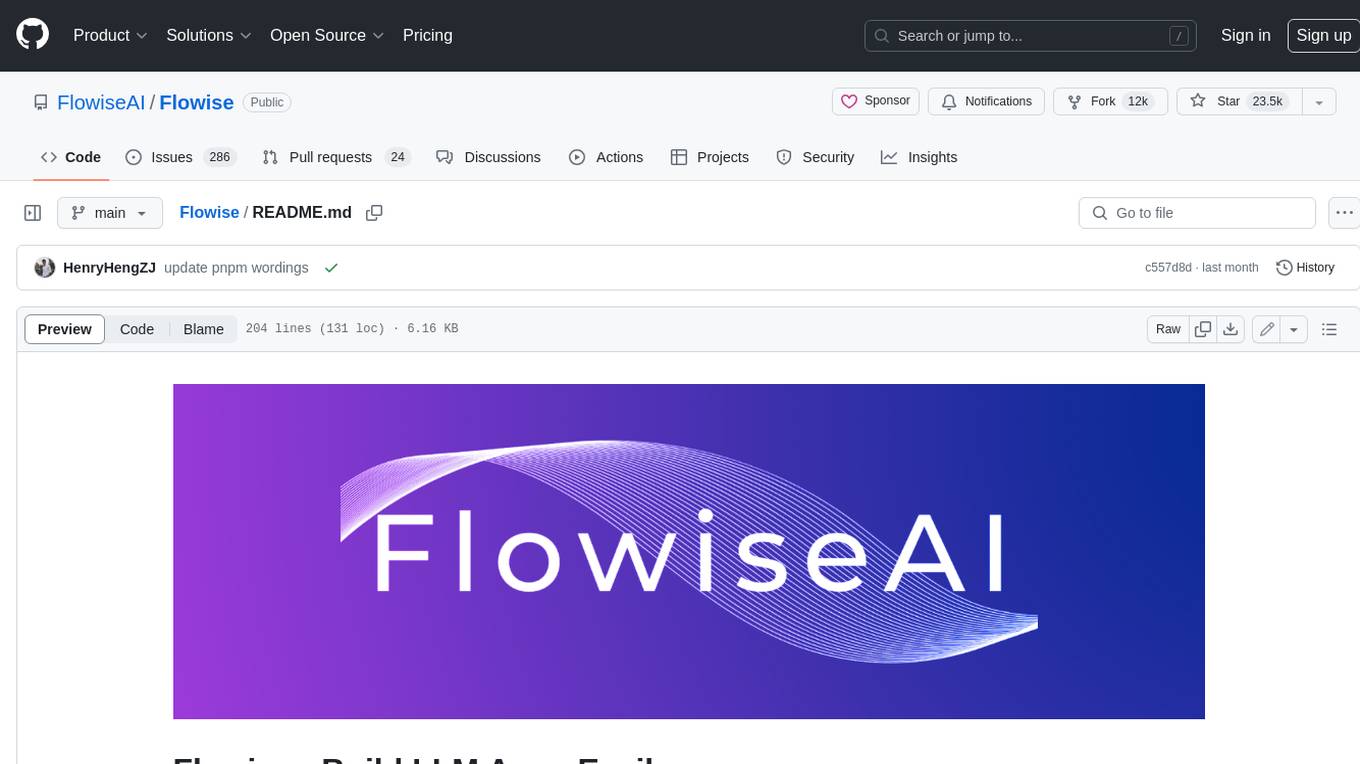
Flowise
Flowise is a tool that allows users to build customized LLM flows with a drag-and-drop UI. It is open-source and self-hostable, and it supports various deployments, including AWS, Azure, Digital Ocean, GCP, Railway, Render, HuggingFace Spaces, Elestio, Sealos, and RepoCloud. Flowise has three different modules in a single mono repository: server, ui, and components. The server module is a Node backend that serves API logics, the ui module is a React frontend, and the components module contains third-party node integrations. Flowise supports different environment variables to configure your instance, and you can specify these variables in the .env file inside the packages/server folder.

nlux
nlux is an open-source Javascript and React JS library that makes it super simple to integrate powerful large language models (LLMs) like ChatGPT into your web app or website. With just a few lines of code, you can add conversational AI capabilities and interact with your favourite LLM.
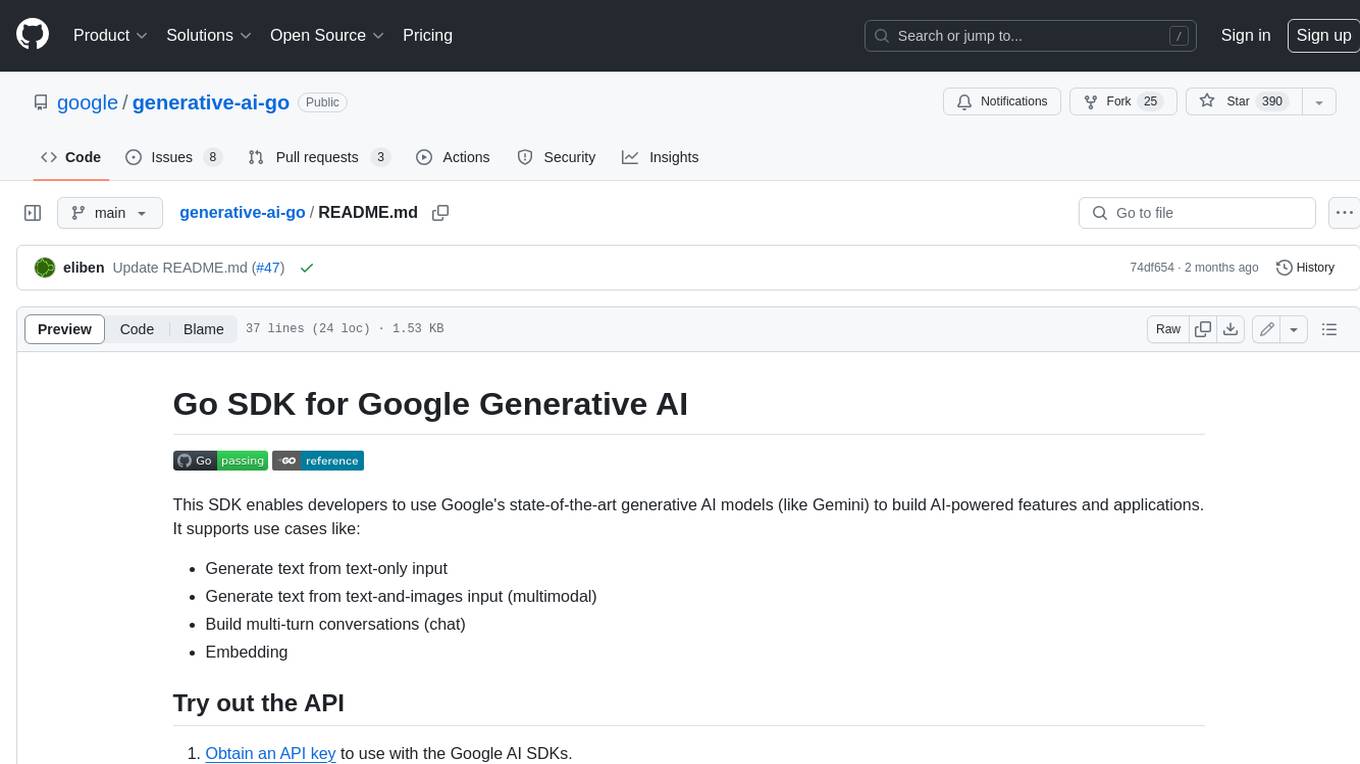
generative-ai-go
The Google AI Go SDK enables developers to use Google's state-of-the-art generative AI models (like Gemini) to build AI-powered features and applications. It supports use cases like generating text from text-only input, generating text from text-and-images input (multimodal), building multi-turn conversations (chat), and embedding.
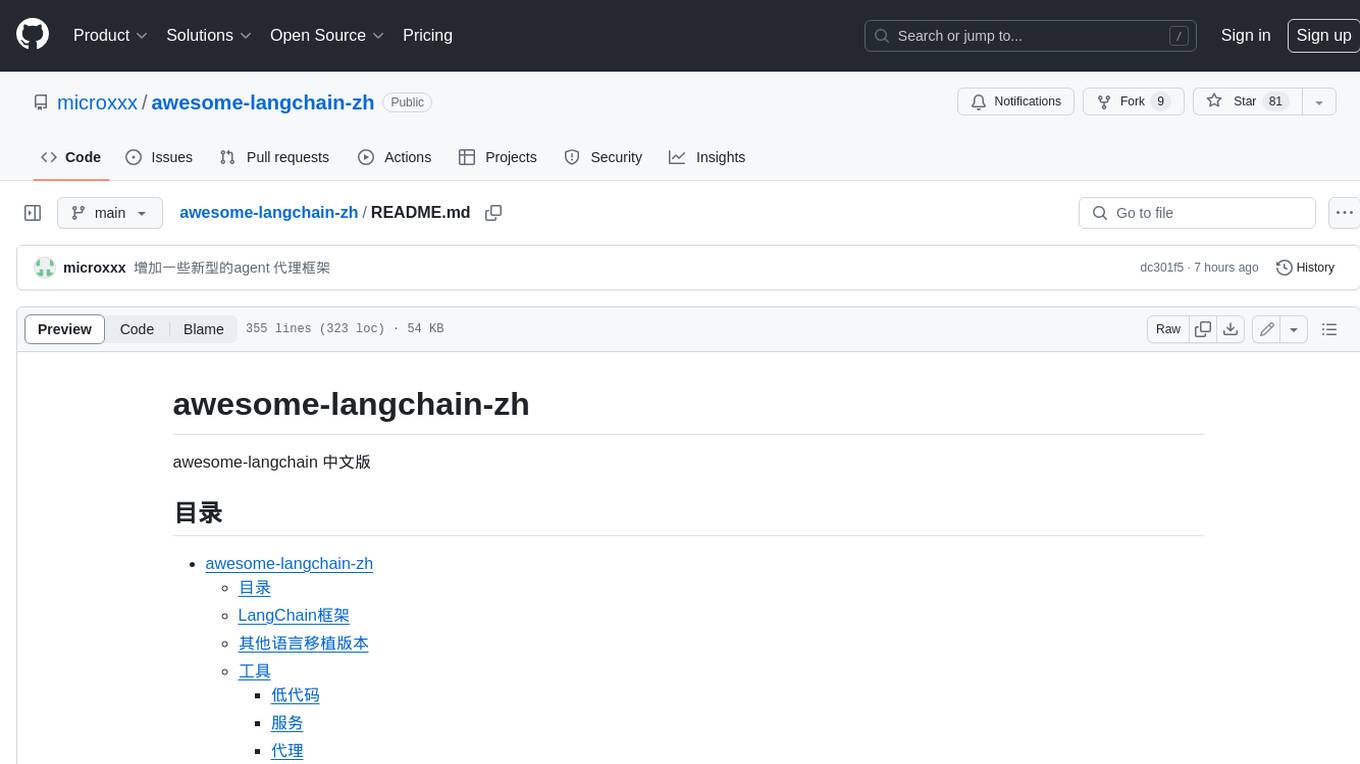
awesome-langchain-zh
The awesome-langchain-zh repository is a collection of resources related to LangChain, a framework for building AI applications using large language models (LLMs). The repository includes sections on the LangChain framework itself, other language ports of LangChain, tools for low-code development, services, agents, templates, platforms, open-source projects related to knowledge management and chatbots, as well as learning resources such as notebooks, videos, and articles. It also covers other LLM frameworks and provides additional resources for exploring and working with LLMs. The repository serves as a comprehensive guide for developers and AI enthusiasts interested in leveraging LangChain and LLMs for various applications.
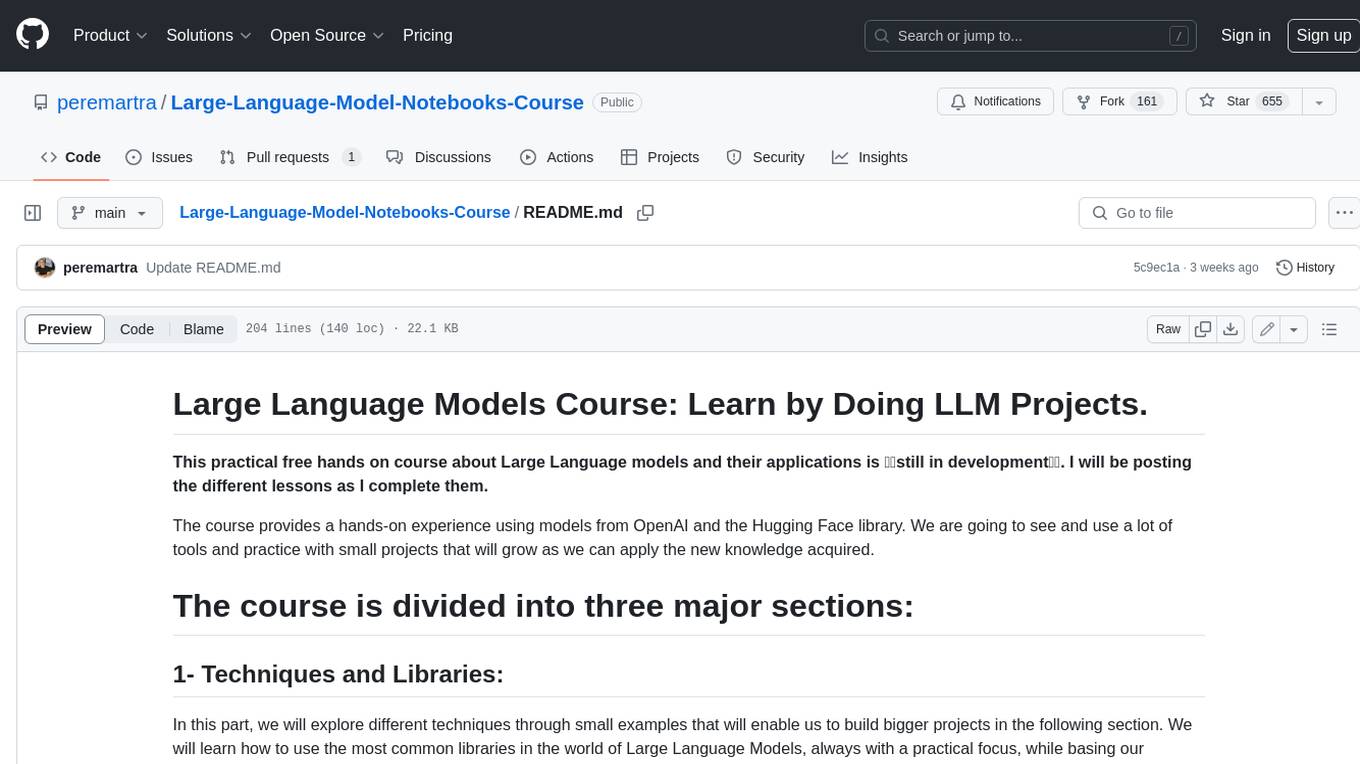
Large-Language-Model-Notebooks-Course
This practical free hands-on course focuses on Large Language models and their applications, providing a hands-on experience using models from OpenAI and the Hugging Face library. The course is divided into three major sections: Techniques and Libraries, Projects, and Enterprise Solutions. It covers topics such as Chatbots, Code Generation, Vector databases, LangChain, Fine Tuning, PEFT Fine Tuning, Soft Prompt tuning, LoRA, QLoRA, Evaluate Models, Knowledge Distillation, and more. Each section contains chapters with lessons supported by notebooks and articles. The course aims to help users build projects and explore enterprise solutions using Large Language Models.
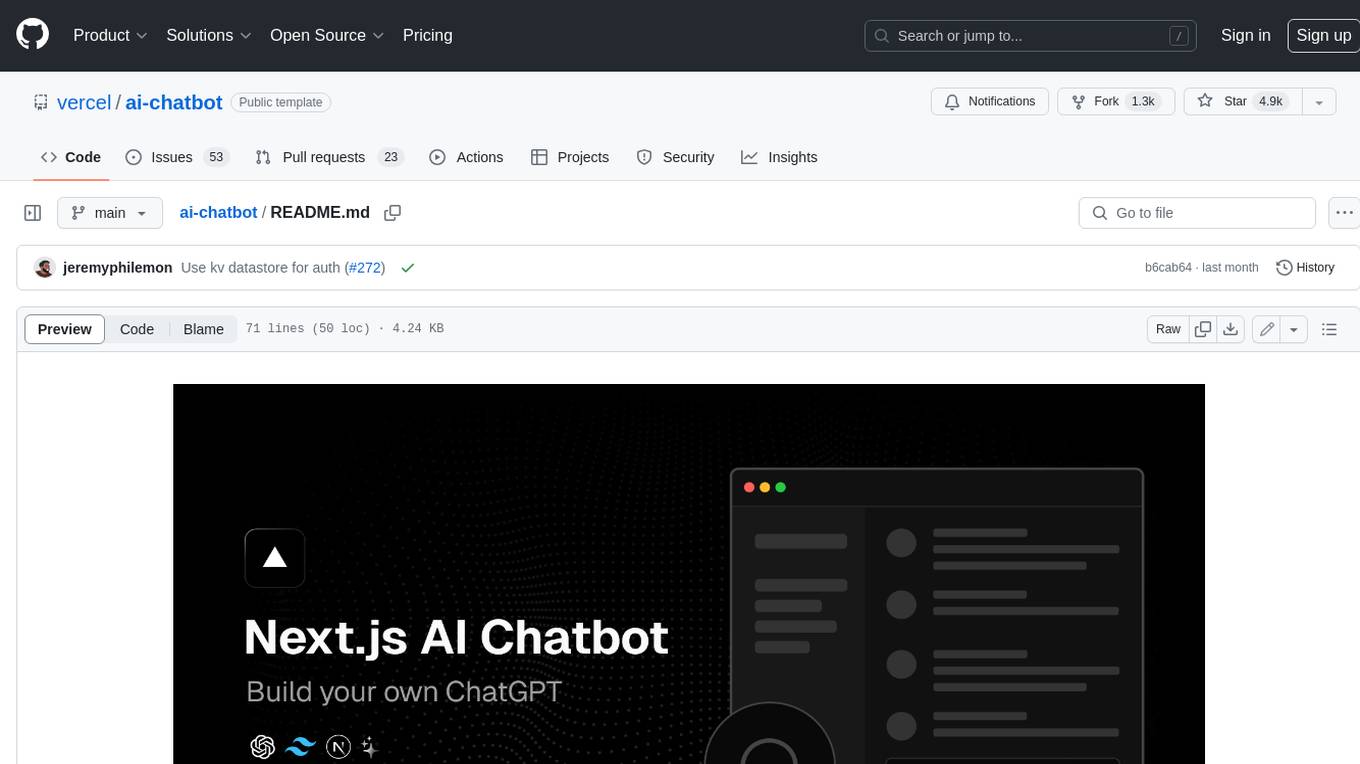
ai-chatbot
Next.js AI Chatbot is an open-source app template for building AI chatbots using Next.js, Vercel AI SDK, OpenAI, and Vercel KV. It includes features like Next.js App Router, React Server Components, Vercel AI SDK for streaming chat UI, support for various AI models, Tailwind CSS styling, Radix UI for headless components, chat history management, rate limiting, session storage with Vercel KV, and authentication with NextAuth.js. The template allows easy deployment to Vercel and customization of AI model providers.
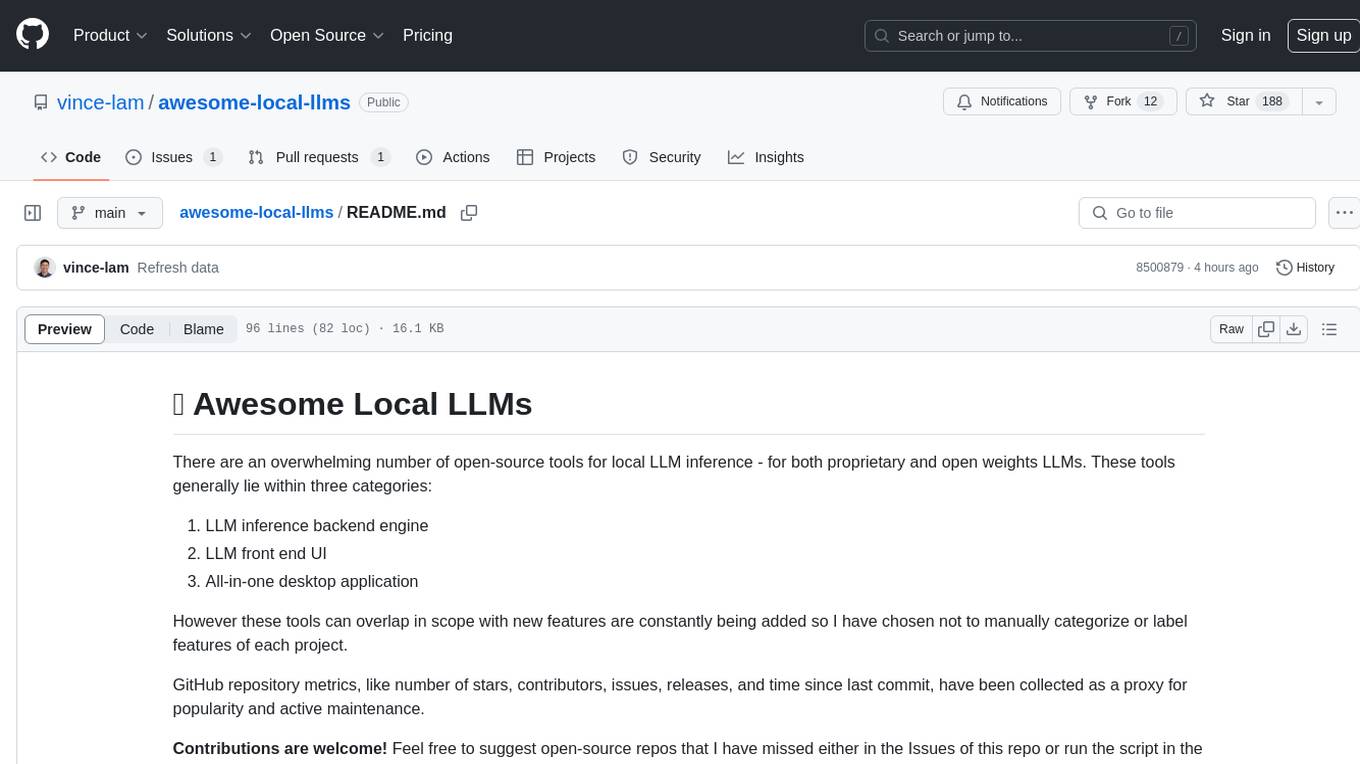
awesome-local-llms
The 'awesome-local-llms' repository is a curated list of open-source tools for local Large Language Model (LLM) inference, covering both proprietary and open weights LLMs. The repository categorizes these tools into LLM inference backend engines, LLM front end UIs, and all-in-one desktop applications. It collects GitHub repository metrics as proxies for popularity and active maintenance. Contributions are encouraged, and users can suggest additional open-source repositories through the Issues section or by running a provided script to update the README and make a pull request. The repository aims to provide a comprehensive resource for exploring and utilizing local LLM tools.
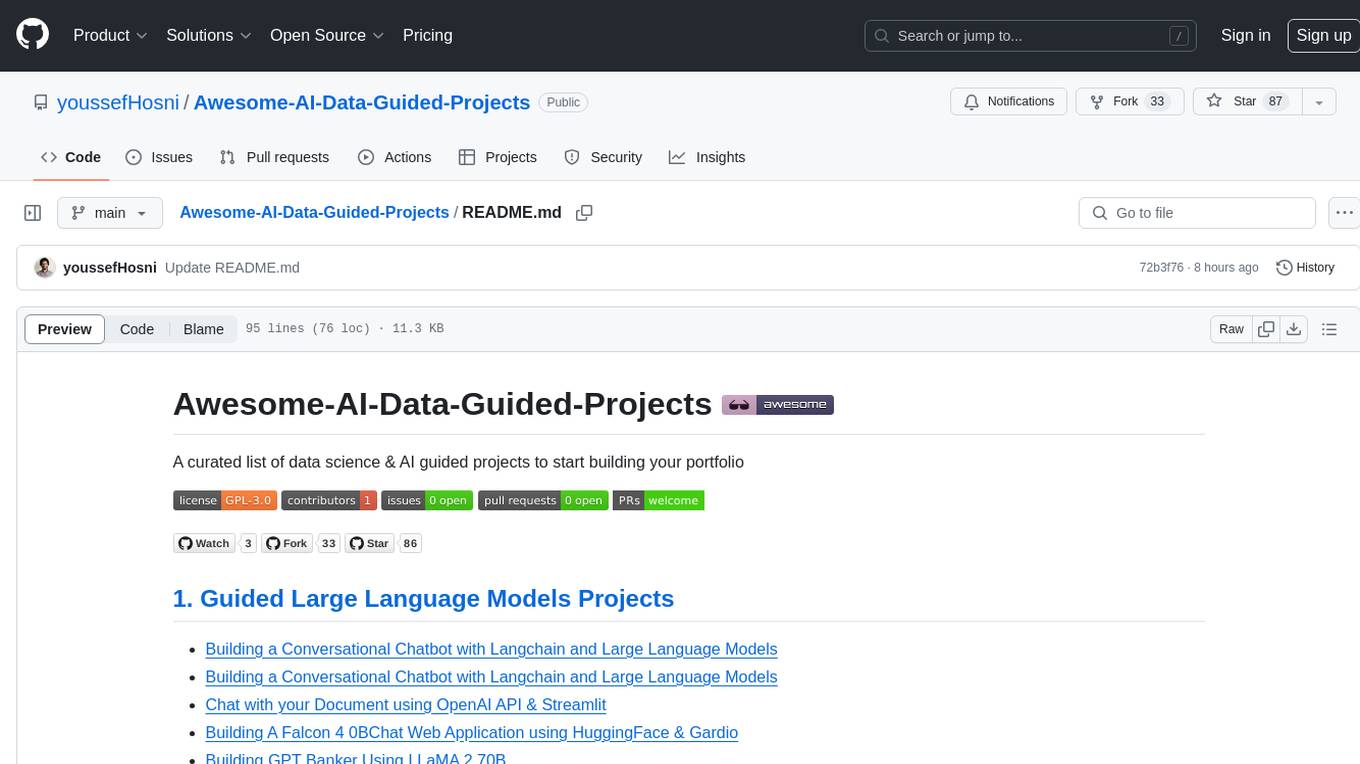
Awesome-AI-Data-Guided-Projects
A curated list of data science & AI guided projects to start building your portfolio. The repository contains guided projects covering various topics such as large language models, time series analysis, computer vision, natural language processing (NLP), and data science. Each project provides detailed instructions on how to implement specific tasks using different tools and technologies.
For similar jobs

sweep
Sweep is an AI junior developer that turns bugs and feature requests into code changes. It automatically handles developer experience improvements like adding type hints and improving test coverage.

teams-ai
The Teams AI Library is a software development kit (SDK) that helps developers create bots that can interact with Teams and Microsoft 365 applications. It is built on top of the Bot Framework SDK and simplifies the process of developing bots that interact with Teams' artificial intelligence capabilities. The SDK is available for JavaScript/TypeScript, .NET, and Python.

ai-guide
This guide is dedicated to Large Language Models (LLMs) that you can run on your home computer. It assumes your PC is a lower-end, non-gaming setup.

classifai
Supercharge WordPress Content Workflows and Engagement with Artificial Intelligence. Tap into leading cloud-based services like OpenAI, Microsoft Azure AI, Google Gemini and IBM Watson to augment your WordPress-powered websites. Publish content faster while improving SEO performance and increasing audience engagement. ClassifAI integrates Artificial Intelligence and Machine Learning technologies to lighten your workload and eliminate tedious tasks, giving you more time to create original content that matters.

chatbot-ui
Chatbot UI is an open-source AI chat app that allows users to create and deploy their own AI chatbots. It is easy to use and can be customized to fit any need. Chatbot UI is perfect for businesses, developers, and anyone who wants to create a chatbot.

BricksLLM
BricksLLM is a cloud native AI gateway written in Go. Currently, it provides native support for OpenAI, Anthropic, Azure OpenAI and vLLM. BricksLLM aims to provide enterprise level infrastructure that can power any LLM production use cases. Here are some use cases for BricksLLM: * Set LLM usage limits for users on different pricing tiers * Track LLM usage on a per user and per organization basis * Block or redact requests containing PIIs * Improve LLM reliability with failovers, retries and caching * Distribute API keys with rate limits and cost limits for internal development/production use cases * Distribute API keys with rate limits and cost limits for students

uAgents
uAgents is a Python library developed by Fetch.ai that allows for the creation of autonomous AI agents. These agents can perform various tasks on a schedule or take action on various events. uAgents are easy to create and manage, and they are connected to a fast-growing network of other uAgents. They are also secure, with cryptographically secured messages and wallets.

griptape
Griptape is a modular Python framework for building AI-powered applications that securely connect to your enterprise data and APIs. It offers developers the ability to maintain control and flexibility at every step. Griptape's core components include Structures (Agents, Pipelines, and Workflows), Tasks, Tools, Memory (Conversation Memory, Task Memory, and Meta Memory), Drivers (Prompt and Embedding Drivers, Vector Store Drivers, Image Generation Drivers, Image Query Drivers, SQL Drivers, Web Scraper Drivers, and Conversation Memory Drivers), Engines (Query Engines, Extraction Engines, Summary Engines, Image Generation Engines, and Image Query Engines), and additional components (Rulesets, Loaders, Artifacts, Chunkers, and Tokenizers). Griptape enables developers to create AI-powered applications with ease and efficiency.

